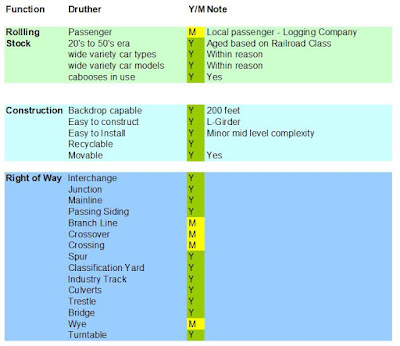Layout Detail. Layout Detail identifies the parameters within which the layout must be designed. It is broken down into two main elements: 5) Layout Design, and 6) Construction to build the railroad.
 In Prototype Interest 1 - Choosing a locale I chose the Western Washington - Olympic Peninsula - Grays Harbor County - Montesano area for the Western Washington Short Line (WWSL).
In Prototype Interest 1 - Choosing a locale I chose the Western Washington - Olympic Peninsula - Grays Harbor County - Montesano area for the Western Washington Short Line (WWSL).
As discussed in Layout Detail - 0 - Designing the WWSL, the NP, the MILW, and the UP were established in Grays Harbor and were conducting business. The Schaefer Brothers Logging Company located north of the Chehelis River and the Clemons Logging Company and the Saginaw Timber Company south of the Chehelis River in what the Forestry Department names the Vesta-North River Watershed.
Deciding to overlay the Olympic Peninsula Logging Company / OPLC onto the Schaefer Brothers Logging Company right of way places us at Brady, Wash. The Schaefer Brothers right of way crosses the NP mainline at Brady. To the north of the NP mainline was a logging yard and the logging railroad continued north into the timber. To the south of the NP mainline was what appears to be a engine servicing/repair area and continuing south as a long spur terminating at the Chehelis river, where the logging railroad had a log dump.
montesano - brady map
 Following the alternative history of the WWSL, Brady continues to be the crossing of the NP by the WWSL, and is upgraded to a junction and interchange. The area between Montesano and Brady and south of the NP main line will be the Headquarters of the WWSL. The WWSL headquarters, arrival, departure and classification yard (Demaine Yard) could easily be located west and south of the junction and NP main line. Montesano will be the official interchange point with the Northern Pacific.
Following the alternative history of the WWSL, Brady continues to be the crossing of the NP by the WWSL, and is upgraded to a junction and interchange. The area between Montesano and Brady and south of the NP main line will be the Headquarters of the WWSL. The WWSL headquarters, arrival, departure and classification yard (Demaine Yard) could easily be located west and south of the junction and NP main line. Montesano will be the official interchange point with the Northern Pacific.
The WWSL will have two sub-divisions. The First Subdivision will begin north of the Brady crossing and will extend into the timber area. First Division will extend trackage rights with the OPLC and have two interchange locations.
The Second Subdivision will begin south of Demaine Yard, (Montesano) cross the Chehelis River at the log dump site, parallel the shared Milwaukee Road and the Union Pacific Railroad main line, then crosses the shared mainline and continues south along the old Saginaw Timber Company mainline to Wickwood. The WWSL will interchange with the MILW and UP at Preachers Slough, Wash, and the Saginaw Timber Company at Wickwood, Wash.
The WWSL
I have conducted some research into the topographic, biotic, soil and climatology of the area in order to better scenic the layout. That information is located at: 5.1a Chehelis River Overview , 5.1b Northern Division Overview, 5.1c Southern Division Overvie.
Physical layout
The WWSL is a bi-level layout. The Division Headquarters (Yellow) and the Second Division and the Saginaw Timber Company (Orange) is located on the lower level; the First Division (Green) and the Olympic Peninsula Logging Company on the upper level.
1. Brady (BR). Brady is home to the NP/WWSL crossing. It is also the location of the fiddle yard used to simulate the NP interchange.
2. Montesano (MO). Montesano is the railroad Headquarters.
3. Demaine Yard has a two track arrival and departure yard, a three track classification yard. The Yardmaster classifies North and Southbound WWSL trains, Class 1 transfers, and picks up and delivers cars at local industrial spurs.
Second Division.
4. Chehelis River. A scenic area.
5. Preachers Slough. (PS). Passing siding, interchange with the MILW and the UP.
6. North River. A scenic area.
7. Wickwood (WK). I found Wickwood on a map in Warren Wing's A Northwest Rails Pictorial. Nothing comes up today in a Google search so i suspect it was a Clemens Logging Company town. I substituted the real location of Arctic, Wash. for the fictional Wickwood. Makes a perfect location for a freelanced pulp and paper mill and other railroad serviced activities. Interchange with the Saganaw Timber Company.
First Division.
8. Schaefer Prairie. The helix moving traffic from the lower to the upper level.
9. OPLC Camp 1 (OP).
If Clemons Logging Company could have a company town so could the
Olympic Peninsula Logging Company. Interchange with the OPLC.
10. Headquarters Junction (HQ).
11. Olympic Peninsula Lumber Company (SM). Location of the OPLC sawmill complex.
12. Tunnel 1 (TU). A scenic area.
13. Polson Canyon (PC). A scenic area.
14. Satsop River (SR). A scenic area.
15. Basalt (BS). Location of the Basalt Sand and Gravel Company.
16. Coal Grove (CG). Location of the O.K. Coal Company.
17. Reload (RE). Location of the OPLC Reload #11. Interchange with the OPLC.






